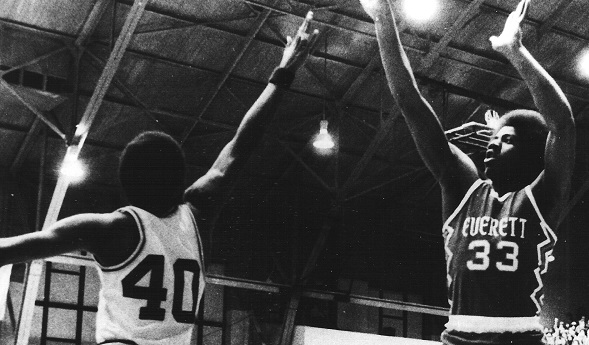
BCAM Names '7s' Retro Mr Basketball Winners
May 1, 2017
Basketball Coaches Association of Michigan
Forty years after scoring his last basket at the high school level, Earvin “Magic” Johnson is finally a BCAM Mr. Basketball.
“When we began talking about this award, we thought of all the great players who never had the opportunity to win it,” said Al Schaffer, chairman of the Association’s Mr. Basketball committee at the announcement of the Michigan’s Mr. Basketball award back in 1981. “Players like Earvin Johnson, Dave DeBusschere, Chet Walker, Frank Tanana, Sr.; Mel Peterson, Richie Jordan, Campy Russell and many, many others.”
In 2010, the Basketball Coaches Association of Michigan launched a decade-long program meant to honor those very athletes. The Retro Mr. Basketball award looks back at the state’s top senior prep basketball players for the years 1920 through 1980. This year marks the eighth year of the project, and places the spotlight on the senior athletes for the years that end in seven – 1927, 1937, 1947, 1957, 1967 and 1977.
“Those six school years include some of the state’s greatest names,” said BCAM president Tom Hursey. “BCAM was incorporated in the summer of 1976, and first presented the ‘Mr. Basketball’ award in 1981 to Lansing Eastern’s Sam Vincent. Earvin ‘Magic’ Johnson was one of the inspirations for the award. It’s nice to see him honored after all these years.”
Members of the Association’s Retro Mr. Basketball committee assembled between sessions of the MHSAA Boys Basketball championships in March to identify, then select the latest group of honorees.
“With their selections, a total of 49 seniors from the Retro years have now been named,” said Ron Pesch, historian for the Michigan High School Athletic Association and the individual tasked with identifying candidates for the award. “When combined with the 37 winners of the modern Mr. Basketball award, Michigan now has 86 individuals we call “Mr. Basketball.”
The names of this year’s selections will be added to plaques that surround the base of the original Mr. Basketball trophy created by BCAM in 1981.
PAST WINNERS OF BCAM’S RETRO MR. BASKETBALL AWARD
(College Attended Shown In Parenthesis)
1980 Tim McCormick, Clarkston (Michigan)
1976 Stuart House, Detroit Denby (Washington State)
1975 Bruce Flowers, Berkley (Notre Dame)
1974 Tony Smith, Saginaw (Nevada-Las Vegas)
1973 Tom LaGarde, Detroit Catholic Central (North Carolina)
1972 Larry Fogle, Detroit Cooley (Canisius)
1971 Michael "Campy" Russell, Pontiac Central (Michigan)
1970 Rick Drewitz, Garden City West (Kentucky)
1966 Rudy Tomjanovich, Hamtramck (Michigan)
1965 L.C. Bowen, Benton Harbor (Bradley)
1964 Willie Betts, River Rouge (Bradley)
1963 Craig Dill, Saginaw Arthur Hill (Michigan)
1962 Ernie Thompson, Saginaw (Bradley)
1961 Reggie Harding, Detroit Eastern
1960 Peter Gent, Bangor (Michigan State)
1956 Mel Peterson, Stephenson (Wheaton)
1955 M.C. Burton, Jr., Muskegon Heights (Michigan)
1954 Pete Tillotson, Ludington (Michigan)
1953 Ron Kramer, East Detroit (Michigan)
1952 Frank Tanana, Sr., Detroit St. Andrew
1951 Webster Kirksey, Saginaw (Eastern Michigan)
1950 Charlie Primas, Detroit Miller (Wayne State)
1946 Jack Forestieri, Benton Harbor (Norte Dame)
1945 Bob Swanson, Lansing Sexton (Michigan)
1944 Dick Rifenburg, Saginaw Arthur Hill (Michigan)
1943 Don Boven, Kalamazoo Central (Western Michigan)
1942 Larry Savage, Saginaw (Northwestern)
1941 Don Osterman, Detroit St. Theresa (Villanova)
1940 Ralph Gibert, Flint Northern (Michigan)
1936 Charles Pink, Detroit Northwestern (Michigan)
1935 John Zwier, Holland Christian
1934 Earl Brown, Jr., Benton Harbor (Notre Dame)
1933 Lincoln Dodson Truss, Flint Northern
1932 Lowell Matteson, Portage
1931 Edward Huttenga, Grand Haven (Western Michigan)
1930 John Tooker, Kalamazoo St. Augustine (Michigan)
1926 Roger Grove, Sturgis (Michigan State)
1925 Joe Truskowski, Detroit Northeastern (Michigan)
1924 Bennie Oosterbaan, Muskegon (Michigan)
1923 Henry Schrumpf, Niles (Western Michigan)
1922 Royal Cherry, Grand Rapids Union (Michigan)
1921 George Haggarty, Ypsilanti (Michigan)
1920 Harry Kipke, Lansing Central (Michigan)
2017 SELECTIONS FOR BCAM’S RETRO MR. BASKETBALL AWARD
(The winner of the award is listed below at the top of the page in ALL CAPS, while finalists for the award follow and are listed alphabetically.)
1977 RETRO MR. BASKETBALL
EARVIN ‘MAGIC’ JOHNSON, LANSING EVERETT – “May be the best prep player ever in Michigan” stated United Press International at the conclusion of his prep career, and today, few would debate that assessment. Johnson totaled 2,012 points in his high school career, including an average of 28.8 points per game as a senior. Dominant across all aspects of the game, opposing coaches praised his ability to control a contest. The sophomore fouled out in his varsity debut, missing about a third of the game, but still grabbed 16 rebounds and scored 12 points against Holt in early December 1974. By February of 1975, Lansing sportswriters called him “Magic.” A first-team Parade All-American as a 6-foot-8½, 198 pound senior, Johnson was named a first-team all-stater by The Associated Press in all three years of varsity play. In 1977, Johnson led Everett to a 62-56 overtime victory over Birmingham Brother Rice in one of the all-time classic Class A title games.
1977 FINALISTS
Rick Baillergeon, Maple City Glen Lake, 6-2 – Scored 16 points as Glen Lake downed Detroit East Catholic 70-68 for Class D championship. The points brought Baillergeon’s four-year career total to 2,144 – second most in the state at the time behind Richie Jordan, who tallied 2,210 points for Fennville between 1962 and 1965, and four more than Dom Jacobetti’s total of 2,140 points, scored over four seasons at Negaunee St. Paul. A 60-percent field goal shooter, Baillergeon continued his playing days at Ferris State.
Tim Bracey, Grand Rapids Creston, 6-2, 170 – Excellent at both ends of the court, Bracey was a two-time scoring champion in the City League and averaged 24.3 points, 13 rebounds, and six assists per game as a senior.
Kevin Smith, Birmingham Brother Rice, 6-1½, 165 – Called “the finest guard to ever play basketball in the Catholic League” by Mick McCabe of the Detroit Free Press, Smith was accurate on 81 percent of his free throws while averaging 29 points, seven assists, five steals and six rebounds per contest as a senior. His 47-foot shot at the end of regulation of the 1977 Class A championship against Lansing Everett sent the contest to overtime.
Jay Vincent, Lansing Eastern, 6-7, 230 – Vincent was a starter beginning his sophomore year but played largely in the shadow of Earvin Johnson. Still, he was the second-leading vote getter on the UPI all-state team. Vincent totaled 1,512 points over his prep career, a number that would have been higher had Eastern been able to get past Johnson and Everett in the District round of the annual MHSAA tournament during those three seasons.
1967 RETRO MR. BASKETBALL
SPENCER HAYWOOD, DETROIT PERSHING – “He just might be the finest 16-year-old player in the United States,” said his coach Will Robinson about the transfer from Mississippi who arrived at Pershing in the fall of the 1965-66 school year. Only the Detroit Free Press named the 6-foot-7 junior to its all-state team that winter, but one year later, the Detroit News, Free Press, Associated Press and United Press International had all discovered Haywood, and named him to their respective top all-state squads. Haywood demanded respect around the boards, grabbing 544 rebounds – 169 on offense and 375 on defense – while blocking 160 shots. A Parade magazine third-team All-American, he averaged 29.1 points per game as a junior and 25.6 over his prep career, hitting on 74 percent of his free throws while dishing out 120 assists. Helped lead the Doughboys to the 1967 Class A championship, the first for Robinson.
1967 FINALISTS
Tim Bograkos, Flint Central, 6-1, 175 – The second player in Flint history to score more than 600 points in his career, Bograkos totaled 726 points over two seasons of varsity play. Honor student and team captain of the football, basketball and baseball teams, as a senior he averaged 17 points per game, leading the Indians to the Class A Final, a 90-66 loss to Detroit Pershing.
Dan Fife, Clarkston, 6-3½, 185 – Averaged 12 rebounds and better than 32 points per contest as a senior. Scored 52 points in a game and totaled 1,589 points over his three years of varsity play at Clarkston. Fife played college ball at Michigan, then returned to Clarkston where he has served as varsity basketball coach for 35 years. In March 2017, the Wolves topped Grand Rapids Christian for the Class A championship – a first for Coach Fife.
Ralph Houston, Muskegon Heights, 6-4½, 178 – Possessing excellent size and speed, Houston averaged just shy of 20 points per game for the Tigers, scoring 381 points total while corralling 208 rebounds as a senior.
Kennedy McIntosh, South Haven, 6-6½, 220 – A Class B all-state selection as a junior, McIntosh earned Dream Team recognition from the Detroit News as a senior, averaging 18 rebounds and more than 25 points per game during his graduation year. Attended Eastern Michigan following high school before advancing to the NBA.
1957 RETRO MR. BASKETBALL
ED BURTON, MUSKEGON HEIGHTS – A rugged rebounder who carried a 20-point-plus scoring average as both a forward and center, the 6-foot-6, 201-pound Burton was the top vote getter in the Detroit Free Press coaches all-state poll. Scored 1,143 points to break the Heights’ career scoring mark set by his brother, M.C. Burton, by two points. As a senior, “Big Ed” hit 20 field goals and tallied 44 points versus Traverse City in tournament Quarterfinal play, and 17 points versus Benton Harbor and star junior Chet Walker in the Semifinals. In the 1957 Class A title contest, Burton scored 25 points, including 13 of 15 shooting from the foul line, against Detroit Austin Catholic and its top ballplayer, junior Dave DeBusschere. Burton’s 31 rebounds against Traverse City in Quarterfinal action still stands as an MHSAA final round record.
1957 FINALISTS
Charles North – Detroit Northwestern, 6-3½, 185 – Led Northwestern to the City Championship, and was the team’s top rebounder and clutch scorer. Later played for the University of Detroit.
Dave Southwell – Parma Western – 6-4, 205 – A repeat first-team all-state selection by the Free Press, Southwell was amazingly agile, and turned in his best games against Parma’s toughest opponents. “Would rather set up his teammates than to score himself,” wrote the Michigan Center coach at the time of balloting for the 1957 all-state team. “He took eight shots against us and hit on five.” High praise considering Southwell put up 47 against Michigan Center as a junior.
Tom Villemure, Newberry, 5-10, 180 – Averaged 33.3 ppg as a guard at Newberry, and was the state’s leading scorer in 1957. Later a two-time MVP at Sault Tech (now Lake Superior State) then continued his playing career at University of Detroit. Served as head coach at Grand Valley State for 24 years.
Tom Wilson, Lapeer, 6-1, 178 – The top name in Class B basketball in 1957. Scored over 1,300 points in his career at Lapeer and 36 points or more in six straight games. Tom was the third of the Wilsons to play football at Michigan State behind oldest brother John, a defensive back at MSU, and Pat, a quarterback and basketball player for the Spartans. Tom would also play both sports at Michigan State.
1947 RETRO MR. BASKETBALL
SAMMY GEE, DETROIT MILLER – A 5-foot-8, 150-pound set-up artist, Gee was a quick thinking floor general and one of the city’s top scorers for coach Will Robinson’s Trojans. Well known across the state despite the fact Detroit Public School League teams did not compete in the MHSAA-sponsored tournament, Gee scored 15 points to lead all scorers as Miller won its first-ever PSL championship before 8,000 fans at the State Fairground Coliseum in Detroit. Miller then downed Detroit St. Joseph in Detroit’s first postseason championship between the PSL and the city’s parochial champion. The game was played in front of 16,041 spectators at Olympia Stadium, at the time the largest crowd ever to see a basketball game in Michigan. As a testament to his skills, Gee was signed by the Harlem Globetrotters out of high school. An outstanding baseball player as well, he was inked by the Brooklyn Dodgers and played minor league ball for the organization for parts of two seasons.
1947 FINALISTS
Bill Agre, Saginaw Arthur Hill, 6-0, 150 – Only Saginaw Valley member to score a spot on the Detroit Free Press all-state first team. An aggressive, hard driving guard, Agre was the Valley’s top defensive player and received the most votes when named to the league’s all-conference team.
Chuck Murray, Birmingham, 5-11 – Another first-team selection by the Times, Murray also was named to the second team by the Free Press. Considered one of the state’s most versatile athletes, competing in football, baseball and track, but basketball was considered his best sport. Held Birmingham’s single-season scoring mark with 210 points in 15 games.
Bob Nagel, Lansing Eastern, 6-2, 185 – A unanimous all-5A Conference first-team selection, Nagel was a first-team selection in the Free Press. An outstanding all-around athlete, he was Class A pole vault champion in the spring of 1947.
Bob VanDyke, Holland – 6-5, 200 – Scored 296 points in 17 games to set a new scoring record at Holland, with six games of 20 points or more.
1937 RETRO MR. BASKETBALL
BOB OSTERMAN, DETROIT ST. THERESA – A 6-foot-4 center, Osterman led Detroit St. Theresa to Class B titles in 1936 and 1937. Only first team repeater on the Detroit Free Press all-state squad, he was named to the paper’s second team in 1935 as a sophomore. Scored 793 points over four years at St. Theresa – better than 11 points per game. Tallied 16 points in a little more than three quarters of play, as St. Theresa downed Marshall in the Class B Final in 1937. Later played football at Notre Dame. Brother of Don, who was named Retro Mr. Basketball for the 1940-41 season.
1937 FINALISTS
Gene Brogan – Lansing St. Mary – A clever dribbler and top-notch playmaker, Brogan was the main cog in St. Mary’s drive to back-to-back Class C championships. Helped the “Big Blue” piece together a 27-game win streak spanning the 1936 and 1937 seasons. The loss, to eventual 1937 Class B champion Detroit St. Theresa, was St. Mary’s lone defeat in 25 matchups in ’37 and one of four over the two-year span.
Jack Newman, Grand Rapids Union – “A fine passer,” Newman was the “leading scorer in the Grand Rapids City League for two seasons.”
Melvin Peterson, Muskegon – Captain and top marksman for the Big Reds, Peterson helped guide Muskegon to a flawless 18-0 mark and the Class A championship. A guard praised for his playmaking ability, he finished third in scoring in the Southwestern Conference with 64 points over 10 games. Later played basketball at Michigan State.
Grady Truss, Flint Northern – The first African-American player to captain Northern’s basketball team, the 6-foot-4 Truss played center and finished his senior year as the second-leading scorer in the Saginaw Valley league with 108 points. A first team all-state selection by the Free Press, Truss earned second team all-state honors as a junior, and was a third team pick as a sophomore. Northern finished as runner-up to the state title in 1935, won the Class A title in 1936, and advanced to the Quarterfinals, losing to cross-town rival Flint Central, in 1937. Grady was the younger brother of Lincoln Dodson Truss, who was named Retro Mr. Basketball for the 1932-33 season.
1927 RETRO MR. BASKETBALL
BILL MCCALL, MUSKEGON – Led the basketball team to a 20-1 record and a Class A championship in the winter of 1927. Named to the All-Tournament team, McCall was also a two-time all-state selection in football, where he helped guide Muskegon to mythical championships in the falls of both 1926 and 1927, the first titles under the leadership of head coach C. Leo Redmond. Later starred at Dartmouth University in both sports.
1927 FINALISTS
Harold Green, Detroit Northern – Named captain of the Detroit Free Press mythical All-City team, Green was “a small thin chap,” who played “like a flash of lightning.” Finished second in scoring in Detroit as a senior, he was considered one of the few players who could do all things well.
George Markley, Pontiac – In his first year on varsity, Markley developed into a brilliant player. His specialty was tapping the ball in from under the basket and his work in the MHSAA tournament, played at Detroit Central, earned him the position of All-Tournament forward.
Al Milanski, Detroit Northeastern – Twice named to the first-team All-City squad by the Detroit Free Press. Top scorer in the city, Milanski averaged better than 10 points per game as a senior. “Fast man down the floor, especially adept at receiving passes and one of the surest shots in the city within a reasonable distance of the basket.”
Ray Priest, Battle Creek Central – Outstanding forward of the state tournament, according to the Battle Creek Enquirer. Played a beautiful floor game, offensively and defensively. First player in Battle Creek history to earn all-state in both football and basketball. Mid-year grad. Played football at the University of Michigan following high school.
PHOTO: Lansing Everett's Earvin Johnson (right) puts up a shot over Lansing Eastern's Jay Vincent during their high school careers.
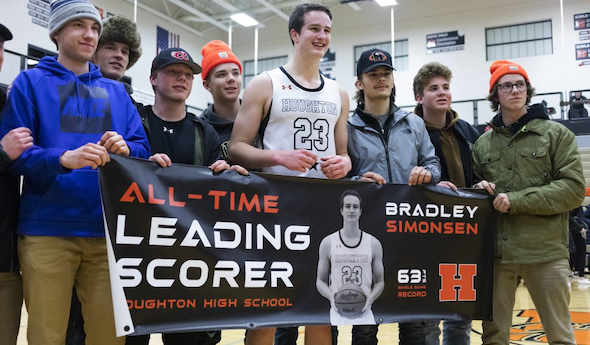
63-Pointer Stirs Memories of UP Legends
February 29, 2020
By Ron Pesch
Special for Second Half
For the first time since 1970 – 50 years ago – and for only the 10th time in Upper Peninsula boys basketball history, a player has scored 60 or more points in a single game.
And that Houghton showing has stoked memories of legendary U.P. scoring showcases going back more than a century.
For the first time, the effort was for naught, at least from a win-loss standpoint, as Houghton dropped a nonconference road contest to Ishpeming 88-83 on Feb. 4. Brad Simonsen hit 23 of 45 field goal attempts, including 7 of 18 from beyond the 3-point arc, as Houghton pushed the play, hoping to narrow what had been a 10-point halftime margin. The 6-foot-6 senior, signed by Michigan Tech, was 10 of 13 from the free throw line and scored 24 points in the fourth quarter, ending the night with 63.
The performance topped Houghton’s school record of 60 points, set by Gary Lange in 1970. The total ranks 14th across the entire state for single game points in a contest, and tied Simonsen for sixth highest above the bridge. There, the mark equaled the top single-game output posted by Stephenson’s Mel Peterson, considered by many the greatest cager ever to come out of the Upper Peninsula.
“Marvelous Mel”
Peterson was the son of a minister and one of 10 children (and eight boys). His older brother, George, broke the U.P. scoring record in 1949 with 44 points in a game for Stephenson High School. The family moved away from the Upper Peninsula following George’s graduation, ultimately landing in southeastern Idaho.
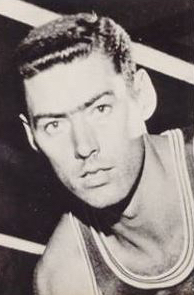 There, Mel emerged as an outstanding athlete for Idaho Falls High School. Standing 6-foot-4½, Peterson’s growth occurred mostly during his freshman year.
There, Mel emerged as an outstanding athlete for Idaho Falls High School. Standing 6-foot-4½, Peterson’s growth occurred mostly during his freshman year.
“I played quite a bit on the varsity my sophomore year,” recalled Peterson recently. “My junior year I started out very, very slow but ended up very good. (However,) I fractured my ankle with about a minute to go in the semifinals of the (1955) state tournament, which we won.”
Peterson led all scorers with 25 points and dominated the boards that night, but had to be helped from the floor, then didn’t play in the title contest. “We lost the state tournament by three points, (43-40 to Kellogg). I was a cheerleader. … It would have been fun to play in the final game.”
When his father received a call to serve the Mission Covenant Church in Wallace, Michigan, about seven miles south of Stephenson, the family returned to the Upper Peninsula for Peterson’s senior year.
“At that time, it was nothing like it is now, where you can find anything about anybody. Then, that wasn’t the case at all,” Peterson said. “So, when we came back, no one had any idea of where I lived before, if I played or not.”
Indeed, prior to football season, one newspaper report indicated Peterson had transferred in from North Dakota, while another listed him as coming from Illinois. Regardless, Peterson emerged as a solid football player at Stephenson High in the fall of 1955. But it was on the basketball court where his scoring and rebounding prowess quickly loomed. He opened the season with 33 points in a win over Gladstone, despite fouling out early in the fourth quarter.
By January, the media had taken to calling him “Marvelous Mel” as Peterson averaged 32.3 points in his first half-dozen games for the Eagles. He drove Stephenson to a 15-1 regular-season record, posting 11 games over 30 points and scoring more than 40 in six.
On Jan. 21, 1956, he poured in 63 points in an 89-44 win over Manistique, shattering his brother’s school record. Mel nailed 25 of 38 shots from the field and 13 of 16 from the free-throw line. At the time, the scoring total exceeded the previous known best in the U.P. of 60 points, scored by Norbert Purol in February 1952. (Purol, from Ironwood St. Ambrose, would later play two seasons of AAU ball in Chicago before matriculating at Kentucky Wesleyan, earning four letters between 1956 and 1959. Wesleyan ended the 1957 season as runner-up to Wheaton College in the inaugural NCAA Small College Tournament – now known as Division II.)
“I don’t remember a great deal about a lot of it. That was so long ago,” said Peterson, laughing. “I guess the thing I appreciate most about the game was that my coach (Duane “Gus” Lord), let me play the whole game, which didn’t happen real often. Probably the thing I remember most about the whole year is that we played a Catholic school, Lourdes, from Marinette, Wisconsin. The first game we played them we beat them 110 to 44. The second game we lost 68-66.”
Peterson’s regular-season total of 570 points also exceeded Purol’s U.P. record of 556 posted over 19 games in 1952. His regular-season average, which had climbed to 35.6, topped the previous best of 29.6, posted by Pete Kutches in 1952 for Escanaba St. Joseph. Then Peterson pushed the per-game-average even higher in the postseason.
Seeing more playing time in the playoffs, “Marvelous Mel,” notched more than 30 points in all seven postseason games (exceeding 40 in three of the contests and 50 once), leading Stephenson to the MHSAA Class B championship win against Detroit St. Andrews in sudden-death overtime, 73-71. There he scored the game-tying bucket with 17 seconds remaining in the three-minute extra frame, and then sunk the game winner 26 seconds into sudden death, where the first team to gain a two-point advantage was proclaimed the victor. That 1956 season saw three of the four basketball championships awarded to U.P. teams.
Peterson finished with 849 points on the year – at the time the best single-season performance in MHSAA history. He averaged 36.9 points across 23 contests – currently eighth in the MHSAA record book.
Following graduation, Peterson nearly signed to play at the University of Minnesota, but felt a better fit at Wheaton College, outside Chicago. There, he earned three All-American honors. As a freshman in 1957, he led Wheaton to victory in that first NCAA Small College Tournament championship game against Wesleyan, earning Most Outstanding Player honors along the way. Today, he remains Wheaton’s all-time leader in career points, points per game, field goals made and career rebounds, all accomplished “without the benefit of a 3-point line, which had yet to be implemented.”
Peterson, who helped the USA team win gold at the 1963 Pan American Games in Sao Paulo, Brazil, played two games for Baltimore in the National Basketball Association (NBA) before a heart condition sidetracked his career. Once the issue was repaired, he returned to play 134 games over three seasons in the American Basketball Association, earning an ABA league championship with the Oakland Oaks in 1969. In 2019, he was inducted into the Small College Basketball National Hall of Fame.
The High-Scoring Sixties
Roger Roell, a senior at Channing, topped Peterson’s U.P. single game record with a 67-point performance in early January 1960 by dropping 31 field goals and five free throws in a 105-55 win over Michigamme.
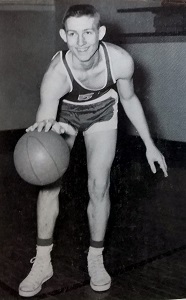 Just over seven weeks later, Jim Manning scored 69 for Trout Creek against Amasa in another lopsided affair, 140-47 (then, a U.P. record for highest team score. The team’s 44 points in the fourth quarter was also a U.P. mark at the time. Trout Creek’s coach, Bruce Warren began substituting in the second quarter).
Just over seven weeks later, Jim Manning scored 69 for Trout Creek against Amasa in another lopsided affair, 140-47 (then, a U.P. record for highest team score. The team’s 44 points in the fourth quarter was also a U.P. mark at the time. Trout Creek’s coach, Bruce Warren began substituting in the second quarter).
Manning, a junior, finished the 1959-60 season as the first player in U.P. history to exceed 600 points in one regular season, totaling 608 over 18 games. He would later pitch in the Major Leagues.
Roell finished second with 569 points in 18 regular-season contests. Third on the regular-season scoring list was another junior, Erwin Scholtz of Hermansville, who tallied 505 across 18 games.
As a senior, the 6-foot-5 Scholtz would post 71 points against Channing, a new benchmark for points in a game in the Upper Peninsula.
Or was it?
The Master’s Thesis
Perhaps because of the media coverage of Scholtz’s accomplishment, in 1962 the Crystal Falls Diamond Drill ran an article detailing the recently unearthed exploits of Ed Burling some 50 years prior. Richard Mettlach, football and baseball coach at Crystal Falls, had uncovered the Burling story.
Mettlach, “in the process of preparing a history of local high school sports which he submitted as a part of the preparation for his master’s degree … discovered that the newspaper records of the early years of high school basketball tell of a match between Iron River and Crystal Falls (played during the 1910-11 season).”
Crystal Falls had downed Iron River, 107-27, according to Mettlach’s research, and Burling had scored all but 10 of Crystal Falls’ points.
“Basketball was different in those days,” said Burling when interviewed by the Diamond Drill in January 1962. Then 68 years old and working as the postmaster in Crystal Falls, he recalled, “when one man was hitting the basket well, the rest of the team fed him the ball and let him shoot. I couldn’t miss that night.”
According to the article, “Burling said as he recalled the game, he made 98 points that night. It appears that 97, however, reportedly verified in two newspaper accounts of the game, will have to be the figure used in the record book.”
Burling recalled that the majority of his shots were from in front of the basket and that rules of the day allowed the top shooter on the team to attempt the free throws.
“The 97 point scoring record would probably have never been uncovered if it had not been for Mettlach’s research,” added the Diamond Drill.
Three more U.P. additions
In 1966, Bob Gale of Trout Creek scored 60 against Mercer, Wisconsin. Gale would later play at Michigan State.
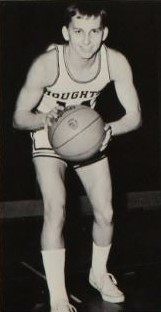 Houghton’s Lange scored his 60 as the Gremlins walloped Painsedale Jeffers, 134-62, on January 23, 1970. One week later, Larry Laitala dropped 65 as Champion crushed Felch, 114-71.
Houghton’s Lange scored his 60 as the Gremlins walloped Painsedale Jeffers, 134-62, on January 23, 1970. One week later, Larry Laitala dropped 65 as Champion crushed Felch, 114-71.
“We had a very good team that year. We had a lot of wings and normally, I wouldn’t play the whole game. My coach was Dominic Jacobetti (who played at Negaunee St. Paul, then Northern Michigan University) and he was a pretty prolific scorer in the U.P. It was one of those nights where the rim was real big,” recalled Laitala, chuckling.
Laitala finished second to Lange in regular-season scoring, 557 to 523, with each athlete playing 17 games.
“Houghton is possibly the best team in any class in the Upper Peninsula,” wrote Hal Schram in the Detroit Free Press, who predicted an MHSAA state title for the team noting that many felt Lange was the top player north of the bridge. The Gremlins, at 17-0, finished as the top-ranked team in Class C in the weekly press polls assembled by the Free Press, The Associated Press and United Press International.
But the season ended earlier than expected for both teams. Houghton fell to St. Ignace in a Regional Semifinal.
“We were beat by our archrival, Republic (61-55) in the first game of the (Class D) Districts, which was kind of an upset,” added Laitala.
Prior to Simonsen’s accomplishment, Lange and Laitala were the most recent players above the Straits of Mackinac to equal or exceed the 60-point minimum established in the MHSAA record book.
The Challenge of Traceability
With modern-day electronic archiving of a number of the state’s newspapers and the accessibility of newspapers on microfilm, an effort has been made to add dates to single-game records, where once only the season of accomplishment was listed. The work continues.
Today, more than 100 years later, the “two newspaper accounts” used back in the 1960s for verification of Burling’s scoring accomplishment have not resurfaced. Hence, neither the date of the game, nor details from period accounts are available for study. That, combined with knowledge that basketball games from the time were usually low-scoring affairs, means doubt is still cast on the mark.
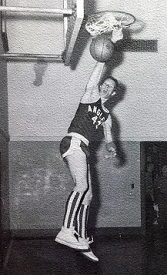 After investigation, the record was accepted by Crystal Falls historian Malcolm McNeil and U.P. sports archivist, Jim Trethewey, a former sports editor of the Marquette Mining Journal who travelled to Crystal Falls to interview Burling. MHSAA historian Dick Kishpaugh ultimately added the performance to the state record book. Questions about the legitimacy of Burling’s total began almost immediately and have resurfaced every 10 years or so. Todd Schulz, a former sports columnist at the Lansing State Journal, wrote extensively on the chase in 2012.
After investigation, the record was accepted by Crystal Falls historian Malcolm McNeil and U.P. sports archivist, Jim Trethewey, a former sports editor of the Marquette Mining Journal who travelled to Crystal Falls to interview Burling. MHSAA historian Dick Kishpaugh ultimately added the performance to the state record book. Questions about the legitimacy of Burling’s total began almost immediately and have resurfaced every 10 years or so. Todd Schulz, a former sports columnist at the Lansing State Journal, wrote extensively on the chase in 2012.
One of the individuals still working to help solve the mystery is Al Anderson of Crystal Falls.
The Diamond Drill was a weekly paper during Burling’s high school days, and newspapers of the time generally didn’t separate prep sporting news into sections. When reported upon, accounts of high school games were usually included in a ‘School Notes’ column.
The season was, without question, a success. “Winning eight out of ten games played, and having three challenges refused, the local basket ball team lay claim to the U.P. championship for the season of 1910-11,” stated the Diamond Drill in the March 25, 1911 edition.
Still, reports uncovered from the period publication continue to cast doubt on the plausibility of the feat occurring in a high school game. “… More basket ball and less indoor foot ball next time will look better to the audience,” noted the newspaper about a 17-10 victory over Niagara, Wis., in mid-December 1910.
“The basket ball game last night resulted in a dispute near the end of the last half with the score 13 to 12 in favor of Crystal Falls. Iron Mountain disputed a decision by the referee and withdrew from the floor,” was the account in the Feb. 18, 1911 edition of the paper.
“There’s an article that was cut out of the physical copy of the December 10, 1910 Diamond Drill,” reports Anderson, who’s been seeking confirmation in fits and starts for nearly a decade. “It looks like it could be the ‘School Notes.’ portion. It’s missing on microfiche copies as well. Perhaps that’s it.”
So the chase to verify continues.
2019-20 season brings sudden burst
Sophomore phenom Emoni Bates of Ypsilanti Lincoln is the latest prep player to etch his name in the MHSAA record book for scoring 63 points. He accomplished the feat in a 108-102 double-overtime win against Chelsea two weeks after Simonsen’s accomplishment. Statewide, that means 34 players have now scored 60 or more points in a game – 30 boys (10 in the U.P. and 20 in Lower Michigan) and four girls (one in the U.P and three in the Lower Peninsula).
Will the list be reduced by one? Time and additional research will tell.
 Ron Pesch has taken an active role in researching the history of MHSAA events since 1985 and began writing for MHSAA Finals programs in 1986, adding additional features and "flashbacks" in 1992. He inherited the title of MHSAA historian from the late Dick Kishpaugh following the 1993-94 school year, and resides in Muskegon. Contact him at [email protected] with ideas for historical articles.
Ron Pesch has taken an active role in researching the history of MHSAA events since 1985 and began writing for MHSAA Finals programs in 1986, adding additional features and "flashbacks" in 1992. He inherited the title of MHSAA historian from the late Dick Kishpaugh following the 1993-94 school year, and resides in Muskegon. Contact him at [email protected] with ideas for historical articles.
PHOTOS: (Top) Brad Simonsen celebrates becoming Houghton's all-time leading scorer Wednesday. (2) Stephenson's Mel Peterson. (3) Trout Creek's Jim Manning. (4) Houghton's Gary Lange. (5) Trout Creek's Bob Gale. (Top photo courtesy of Houghton Daily Mining Gazette. Peterson photo courtesy of Upper Peninsula Sports Hall of Fame. Houghton and Trout Creek photos courtesy of those schools' yearbook departments.)

